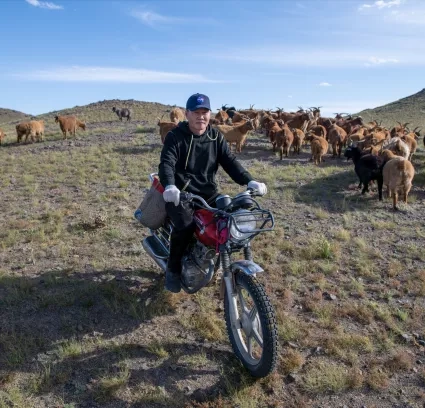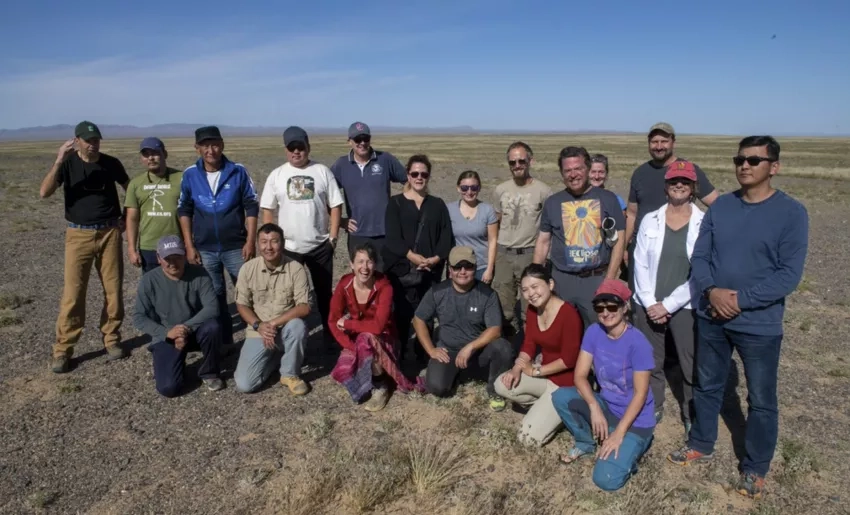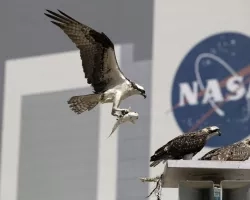Cashmere: it’s an iconic part of luxury fashion and a silky soft way to keep warm in the winter. But there’s a lot to unravel about the way it's made. Cashmere wool comes from goats living in harsh climates like the Gobi Desert in Mongolia. The drier the climate, the finer the wool — and the bigger the risk to the animals, the herders who raise them, and the ecosystem. An unlikely group of allies have been working together to help manage those risks and make the cashmere industry more sustainable.
Luxury fashion conglomerate Kering, Mongolian mining company Oyu Tolgoi, nonprofit Wildlife Conservation Society, and scientists from NASA and Stanford University collaboration called the Natural Capital Project (NatCap) teamed up to form the Sustainable Cashmere Project. These disparate organizations all wanted to reduce the impacts cashmere has and reverse damage done to the Gobi Desert rangelands.
Oyu Tolgoi’s financial backers required the mining company to make a 15 percent improvement to the area’s conditions. Kering wanted to secure a sustainable and high-quality source of cashmere for their supply chain. The scientists at NatCap aimed to help them tease apart the impacts that rangeland management and climate had on rangeland conditions in the Gobi.
This project is a successful example of valuing natural capital (our natural lands and waters and the organisms that inhabit them) and ecosystem services (the flow of benefits it provides to people). In the Gobi, natural capital in the form of rangeland ecosystems provides ecosystem services like fodder for livestock, wind and dust storm regulation, groundwater recharge and mitigation of extreme events like flash floods. A vast array of wildlife also provides values to tourism and other cultural ecosystem services.
Businesses are increasingly recognizing the importance of natural capital to their long-term prosperity and are using a range of accounting techniques to understand their impact on the planet and invest in preserving and restoring it. The Sustainable Cashmere Project goes one step forward in trying to reinvent business to be regenerative.
“I think this is the way of the future for us,” said Cindy Schmidt, an associate program manager with NASA’s Applied Sciences Ecological Forecasting program. “There are a few projects in our program on ecosystem accounting and ecosystem services. We’re trying to really look at the benefits of the ecosystems whether it’s water quality or maintaining mangroves, or in this case grasslands in Mongolia, what those benefits are to people. [The Sustainable Cashmere Project] is really leading the way in that area.”
Monitoring natural capital in the Gobi Desert
The Sustainable Cashmere Project was one of the first NatCap projects to use remote sensing data, Schmidt said. The Gobi spans roughly 500,000 square miles, making traditional field monitoring nearly impossible. It’s also incredibly diverse — the landscape and vegetation can vary greatly from one square mile to the next. Satellite data helped the project monitor a much larger area of land than they could have on foot, and with greater accuracy and at lower cost.
NatCap scientists Becky Chaplin-Kramer and Ginger Kowal worked together to build a tool that would monitor current conditions and provide models predicting future conditions. To build those models, they input satellite data showing rangeland conditions as well as weather data like rain gauges. Given the vastness of the Gobi and its variability, they had to take things one step further.
They used CHIRPS data to feed spatially-explicit and temporally dynamic ecosystem models, and used ISIMIP and WorldClim climate projections to predict future rangeland and livestock conditions. The spatially resolved climate data helped them represent the heterogeneity in rangeland production and consequently livestock health, which advanced beyond previous models based on data from individual weather stations.
“It matters a ton in terms of outcomes like productivity or condition of the rangeland if you can capture that variability rather than having one representative point that’s supposed to stand for what’s happening in the whole place,” said Kowal, the project’s geographic information system programmer analyst.
After analyzing the models they built, the scientists made an interesting discovery: weather and climate had a much stronger impact on rangeland conditions than the goats’ grazing. Although herders’ management practices certainly played a role, the team noticed a huge difference between a wet year in 2018 and a dry year in 2019 — from flash floods to major droughts.
“It was the plan of the whole project to change grazing practices to change the quality of the rangelands,” said Chaplin-Kramer. “But the rangelands are so driven by climate that there’s only so much of a difference you can make. What you can do a lot better is protect herders and their livelihoods by trying to adapt herd sizes to fit better within the bounds of the system. We had to change tactics there — the whole project, not just the science."
Moving the project in a dew direction
The team shifted the focus of their models to help the herders better prepare to manage their herds through different rangeland conditions. They worked on using satellite imagery to provide scenario planning based on the weather. For example, herding practices could change in a wet year versus a dry one. Ultimately, the project aims to get this information into the herders’ hands.
"Because you’re using imagery, you can actually draw maps with boundaries, with the images overlaying,” said Stuart Anstee, program director of the Sustainable Cashmere Project. “It’s a really powerful tool when working with the herders. Maps resonate with them really well. They have a unique understanding of the environments they live in."
Anstee and fashion company Kering were also able to use the insights gleaned from these models to begin improving the supply chain itself. With better information on rangeland use, they could determine the cost of monitoring, management and planning, which allowed them to build those costs into the pricing throughout the supply chain.
Another project partner, Wildlife Conservation Society, worked directly with the herders to encourage change by building trust and relationships with them. They hope to eventually help herders reduce their herd sizes, as well as making the goats healthier with better management of the grasses and veterinary care. By learning new cashmere brushing and storage techniques, herders can improve cashmere yields and quality. This means better livelihoods for them and a shorter, cleaner supply chain for Kering.
Measuring the impacts of the Sustainable Cashmere Project
The Sustainable Cashmere Project’s approach in Mongolia has been so successful that it prompted Anstee to spin off a company called Good Growth. Anstee’s company created a business model with sustainability and regenerative practices as its core focus. They have started pilot projects in other rangeland areas of Mongolia and Patagonia.
“Becky [Chaplin-Kramer] and her team produced a tool that will be extremely useful for monitoring rangelands — which is notoriously difficult to do with remote sensing,” said Schmidt. “They came up with a product that can be used by all these different organizations. These end users were able to use these tools and data for accomplishing their own goals.”
Businesses, government decision makers and nonprofits alike can use the information provided by these tools to better understand how different factors like climate change and grazing impact rangeland ecosystems worldwide. They can then make more informed decisions about supply chains and conservation that will benefit the people and animals who live on rangelands — and the planet, too.
To learn more about this work, read about it in the NASA.gov story, NASA "Steppes” onto the Runway to Make Mongolian Cashmere Sustainable
To learn more about the lead project scientist Becky Chaplin-Kramer, a profile about her is on the Applied Sciences website, Cashmere in Crisis: Becky Chaplin-Kramer’s Mission to Restore Overgrazed Rangelands






